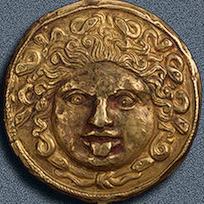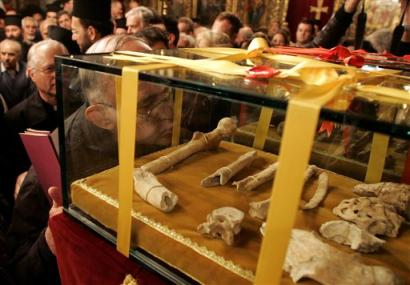
Scythian gold Medusa, 4th Century BC
 Scythian gold Medusa, 4th Century BC |
The Encyclopedia of Ukraine describes the Pereshchepyna Hoard as follows:
One of the richest finds in Ukraine, discovered near Mala Pereshchepyna, now in Novi Sanzhary raion, Poltava oblast, in 1912. Nearly 25 kg of gold and 50 kg of silver artifacts � including 5th-to 7th century Byzantine and Iranian art objects, gold and silver dishes, 7th-Century Byzantine coins, jewelry, a plate bearing the emblem of the bishop of the Greek colony Tomis, now Constanta in Rumania, and a Sasanian plate with a portrait of Shapur II � were found. Scholars believe the hoard to be booty from raids into Byzantine territory. The collection is now housed at the Hermitage in St Petersburg. Danylo Husar Struk (Editor), Encyclopedia of Ukraine, Volume III, University of Toronto Press, Toronto Buffalo London, 1993, p. 846. |
The discovery of a hoard in 1912 in the neighbourhood of Poltava near the village of Malaya Pereshchepina was not in itself a rare event, but in its wealth and diversity this hoard far exceeds all others. It is rightfully regarded as one of the richest finds from the period of the nomadic migrations. The State Hermitage Museum at www.hermitagemuseum.org/html_En/03/hm3_2_13.html |
|
|
|
 |
|
Actual
report on the Saturday, 27-Nov-2004 return of religious relics by Catholic Pope John Paul II of Rome to Orthodox Patriarch Bartholomew I of Istanbul. |
Hoped for
report on the Sunday, 27-Nov-2005 return of the Pereshchepyna Treasure by Russian President Vladimir Putin of Moscow to Ukrainian President Viktor Yushchenko of Kyiv. |
Pope John Paul II, in a gesture of friendship with the Orthodox Church, on Saturday handed over the bones of two early Christian saints that were brought to Rome from ancient Constantinople centuries ago. |
Russian President Vladimir Putin, in a gesture of friendship with Ukraine, on Sunday handed over the Pereshchepyna Treasure that was brought to St Petersburg from Mala Pereshchepyna, Ukraine, in 1912. |
The Vatican said the return of the saints' relics was part of the pope's efforts to promote Christian unity and dismissed any suggestion that John Paul was "asking pardon" for their removal by Crusaders from the seat of the Orthodox Church. |
The Kremlin said that return of the Pereshchepyna Treasure was part of the Russian President's efforts to promote Slavic unity and dismissed any suggestion that Vladimir Putin was "asking pardon" for its removal by Russian archeologists from its place of discovery in Ukraine. |
The pope sat beside Ecumenical Patriarch Bartholomew I, spiritual leader of the world's Orthodox Christians, in St. Peter's Basilica as the bones of the saints, resting on yellow velvet in crystal and alabaster reliquaries, were brought to the altar. |
The Russian President sat beside Viktor Yushchenko, President of Ukraine, in the Hermitage Museum as the Pereshchepyna Treasure, resting on yellow velvet within crystal and alabaster display cases, was paraded before them. |
While a choir sang in Greek and Latin, the two religious leaders blessed the relics, before the reliquaries were carried away on biers by Vatican ushers in dark suits acting as pallbearers. [...] |
While a choir sang in Ukrainian and Russian, the two national leaders admired the relics, before the display cases were carted away by Hermitage ushers in dark suits acting as porters. [...] |
In remarks read for him by an aide, the frail pontiff called it a "blessed occasion to purify our wounded memories" and to "strengthen our path of reconciliation." |
In remarks made by himself, the robust President of Russia called it a "blessed occasion to purify our wounded memories" and to "strengthen our path of reconciliation." |
"I will never tire" in efforts to achieve it, the pope said. |
"I will never tire" in efforts to achieve it, the Russian President said. |
Bartholomew, speaking next, said the handover repaired "an anomaly" and "ecclesiastical injustice" and that it was a sign that there are no "insurmountable problems in the Church of Christ." |
Yushchenko, speaking next, said the handover repaired "an anomaly" and "national injustice" and that it was a sign that there are no "insurmountable problems in the Slavic sphere." |
The Orthodox leader, speaking in Italian, said the gesture also served as an example to those holding religious treasures sought by others. |
The Ukrainian leader, speaking in Russian, said the gesture also served as an example to those holding archeological treasures sought by others. |
In Istanbul later Saturday, bells rang out in celebration as the remains were carried in a candle light procession into the Cathedral of St. George. |
In Kyiv later Sunday, bells rang out in celebration as the Pereshchepyna Treasure was carried in a candle light procession into the Kyiv Historical Museum. |
"For eight hundred years, these relics have been in exile," Bartholomew said at service. "This gesture differentiates (Catholic leaders) from the deed of their predecessors eight centuries ago." |
"For close to a century, this treasure has been in exile," Yushchenko said at service. "This gesture differentiates Russian leaders from the deed of their predecessors almost a century ago." |
Clear glass cases containing the bones were symbolically placed in front of patriarch's throne. Bartholomew bowed and crossed himself as hymns of praise were chanted. |
Clear glass cases containing the treasure were symbolically placed in front of the Ukrainian President's seat. Yushchenko bowed and clasped his hands in his characteristic expression of solidarity as hymns of praise were chanted. |
Bartholomew and John Paul have both emphasized reconciliation between their churches, which split in 1054 over the growing power of the papacy. [...] |
Yushchenko and Putin have both emphasized reconciliation between their nations, which split in 1991 over the oppression of the Kremlin. [...] |
In a statement issued Saturday, papal spokesman Joaquin Navarro-Valls emphasized that Gregory's remains were brought to Rome in the earlier century and denied that the pope was seeking pardon for the removal of the saints' remains. |
In the statement issued Sunday, Russian spokesman Ivan Ivanych emphasized that the Pereshchepyna Treasure was brought to St Petersburg almost a century ago, and denied that President Putin was seeking pardon for the removal of the Treasure. |
"Without negating the tragic events of the XIII century," Navarro-Valls said, the gesture was intended to promote unity between Catholics and Orthodox. |
"Without negating the tragic events of the XX century," Ivanych said, the gesture was intended to promote unity between Russians and Ukrainians. |
The remains have been kept in St. Peter's Basilica. |
The remains have been kept in the Hermitage Museum. |
In 2001, John Paul apologized for Roman Catholic involvement in the Constantinople siege. |
In 2001, President Putin apologized for Russian involvement in the Ukrainian famine. |
The pope has made reconciliation among the divided Christian churches one of the major themes of his papacy [...]. [...] |
President Putin has made reconciliation among the divided Slavic nations one of the major themes of his presidency [...]. [...] |
John Paul has also apologized for sins committed by Catholics against other Christians. |
President Putin has also apologized for sins committed by Russians against other Slavs. |
 John Paul II shows Our Lady of Kazan to Russian President Vladmir Putin. |
|
|
"Despite the division which sadly still persists between Christians, this sacred icon appears as a symbol of the unity" of Christ's followers, the Pope wrote. He told the Russian prelate that he had often "prayed before this sacred icon, asking that the day may come when we will all be united." And he concluded his message by sending the Patriarch "a fraternal kiss in our Lord." |
"Despite the division which sadly still persists between Slavs, this sacred Treasure appears as a symbol of the unity" of the Slavic people, President Putin wrote. He told the Ukrainian President that he had often "meditated before this sacred Treasure, asking that the day may come when we will all be united." And he concluded his message by sending President Yushchenko "a fraternal kiss in our Amity." |
Torque (Grivna) |
|
Overlay for a Goryt (Case for a Bow and Arrows) |
|
|
|
|
|
|
|
|
|
|
|